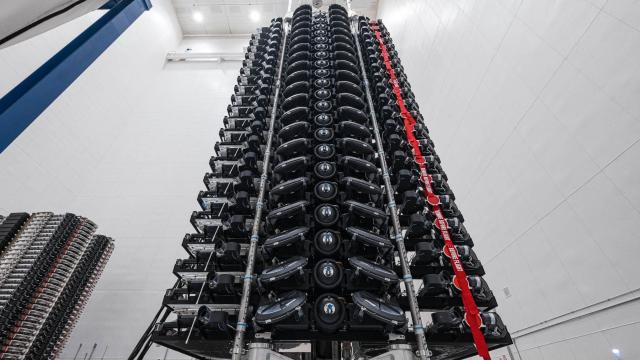The Starlink V2 Minis, a smaller version of SpaceX’s next-generation internet satellites — which have yet to launch — have turned on and are actively transmitting data back down to Earth.
Earlier this week, SpaceX notified the Federal Communications Commission (FCC) that the company has “initiated communications” between its Gen2 satellites and licensed stations within the United States, according to an FCC filing that was first reported by PCMag. It’s still not clear, however, whether the next-generation satellites have started beaming internet to consumers or if SpaceX is still configuring its V2 Minis. SpaceX did not immediately respond to Gizmodo’s request for clarification.
SpaceX launched the first batch of 21 miniaturized versions of its next-generation Starlink satellites on February 27. Things were looking a little rough for that first batch, with at least one of the satellites being deorbited around a month after the inaugural launch. But it seems that the V2 Minis have got it together now, with the most recent batch of 22 next-generation satellites launching on May 19.
The V2 Minis are a compact version of the full-sized Gen2 satellites, which are too big to be carried to orbit on board the company’s Falcon 9 rocket and instead require the payload capacity of the heftier Starship. SpaceX’s Starship rocket completed a less-than-perfect test flight in April and is currently waiting on the go-ahead for a chance to launch again.
The V2 Minis are meant to fill in the gap until Starship can become fully operational, helping SpaceX meet the growing demand for its broadband internet. The next-generation satellites are equipped with more powerful antennas and high-speed frequencies.
Bigger but dimmer
Although three to four times larger than their predecessors in orbit, the V2 Minis appear to be less bright, which is welcome news. A study recently uploaded to the preprint arXiv claims that the next-generation satellites are approximately ten times fainter than the original Starlink satellites, indicative of SpaceX working to mitigate the brightness effects of its internet constellation on astronomical observations.
“SpaceX has extensively worked on improving the dimness of the sats, and [study author Anthony] Mallama’s observations appear — tentatively — to suggest they have been successful,” Jonathan McDowell, an astronomer at the Harvard-Smithsonian Centre for Astrophysics, told Gizmodo in an email.
SpaceX currently has 4,265 satellites in orbit and wants to send tens of thousands more to low Earth orbit. The orbiting satellites reflect sunlight, thereby adding a lot of noise to images captured by ground-based observatories, appearing as bright streaks in data gathered by astronomers.
The company has been working with the Federation of Astronomical Societies to dim its satellites in an effort to make them less disruptive for astronomers, agreeing to keep their magnitude at a maximum of seven to alleviate the issue. The study found that the V2 Minis were at a brightness magnitude of 6.5 after they were raised to their non-geostationary orbit and their solar arrays were directed to reduce brightness, making them difficult to see with the naked eye.
The fact that the V2 Minis are dimmer is a good start, however, as the full-sized next-generation satellites are expected to be much larger, according to McDowell. “Those sats are so big that I expect they will be brighter than the magnitude 7 target the community has asked for,” he explained. Current Starlink satellites weigh about 260 kilograms, but the future versions are going to weigh in at 1,250 kilograms.
So, while the miniature versions of SpaceX’s next-generation satellites are dimmer, astronomers are still anxiously awaiting the launch of their full-sized successors.
